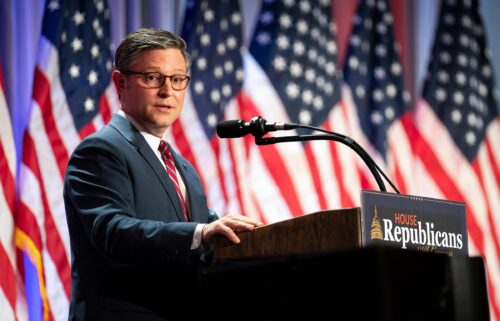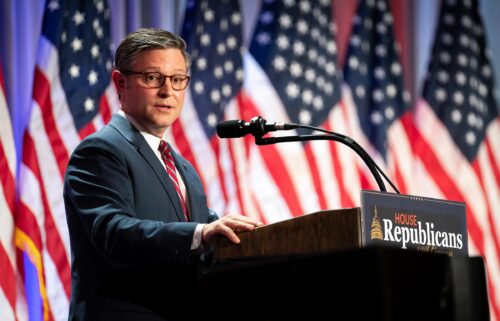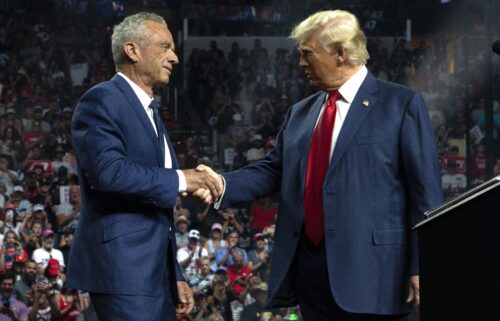Trump’s ground game relies on untraditional strategies to draw out battleground voters
CNN
By Steve Contorno and Fredreka Schouten, CNN
(CNN) — When absentee ballots first landed on doorsteps in Michigan last month, so did Paul Hudson, a Grand Rapids lawyer and a Republican running to represent the area in Congress. Armed with an app that told him where likely voters lived and which houses might be swayed, he spent that morning walking a densely populated purple community where single-story ranches with Trump flags neighbor homes with “Harris Walz” signs on their lush, well-manicured lawns.
It’s a conventional strategy to compete in close races, one battle-tested by campaigns big and small every election. And it’s a playbook that former President Donald Trump’s campaign has tossed aside.
Targeting irregular voters, teaching supporters to surveil polling places and bombarding states with voting-related lawsuits – this is the machine the Trump campaign has built for an election that many expect to hinge on just tens of thousands of ballots cast across seven battleground states. It’s a gamble, Trump’s campaign internally acknowledges, but one that they insist is built on data they have collected over nearly a decade and tested for the past six months.
That, and tens of millions of dollars injected lately by a super PAC aligned with tech billionaire Elon Musk, one of Trump’s most vocal and influential supporters.
The campaign’s untraditional strategy was on display when conservative commentator Tucker Carlson came to Grand Rapids last month. He urged his audience to download an app – 10xVotes – that promises to help them find the non-voting conservatives among their family and friends. Days later, the Michigan state party chairman also plugged 10xVotes when he rolled into Traverse City, Michigan, alongside Trump running mate JD Vance.
Elsewhere in the state, the Trump campaign is holding “election integrity” training, teaching conservatives to be poll watchers, including in areas where Republicans normally win by wide margins. Meanwhile, the Trump campaign and Republican Party are suing the state of Michigan to keep local Veteran Affairs offices and other federal outposts from offering voter registration.
The approach marks a stark contrast to how Trump won the Grand Rapids metro area and other battlegrounds eight years ago, when voter outreach efforts were coordinated by the Republican Party and organized out of regional field offices. And it’s one that has attracted plenty of detractors among GOP strategists, who say they see little evidence of the sophisticated political apparatus the Trump campaign claims is in motion. They worry too much emphasis has been placed on people who are disengaged from politics and on appeasing Trump’s fixation with relitigating the 2020 election.
“It’s political malpractice,” said Dennis Lennox, a veteran Republican operative in Michigan. “It’s a Hail Mary.”
Trump’s campaign believes the approach is reflective of the candidate they are trying to get across the finish line in a narrow race against Vice President Kamala Harris – one whose celebrity and brash style grants him unique appeal among those who don’t often vote but whose first turn in the White House turned off many swing voters that candidates traditionally fight for.
That work is taking place in parts of the country that the Trump campaign never set foot in four years ago, Trump’s political director James Blair said. In Michigan, for example, Trump’s 2020 campaign concentrated their outreach efforts in the Detroit suburbs and around Grand Rapids, according to an internal data mapping where the campaign spoke to voters. This time, the map, reviewed by CNN, shows much more intense activity throughout less populated central Michigan as well as more activity in Detroit, where the campaign says it is making a coordinated push for Black men.
Blair said voters who turned against Trump won’t change their mind because someone knocked on their door.
“We have a narrower view than others who is effectively persuadable at a door,” Blair said. “But what a door is very good at is turnout, particularly for low and mid propensity voters who don’t regularly get contacted by campaigns and may need an explanation of what their voting options are.”
Few places swung harder away from the former president than the Grand Rapids metro area.
Across a revitalizing downtown and in the surrounding neighborhoods nestled against apple orchards and farm fields, swing voters are plentiful. So are moderate Republicans – a vestige of the region’s early Dutch settlers and the lasting influence of its most famous son, former President Gerald Ford, who once represented this western expanse Michigan in Congress. They showed up in force in the GOP presidential primary – one-third of Republicans in surrounding Kent County cast ballots for former South Carolina Gov. Nikki Haley over Trump.
But rather than courting those voters, Trump’s campaign is in search of new ones.
Hudson, who is challenging freshman Rep. Hillary Scholten, the first Democrat to represent Grand Rapids in three decades, acknowledged Trump’s singularity could provide him a different path to winning his district. Still, he made clear his focus is on winning the middle.
“That strategy would be crazy for anyone else,” Hudson said. “They’re low propensity votes for a reason. But I get the sense they’re committed to it.”
‘How do we make sure this all works together’
For much of the year, the Trump campaign has relied on untested outside groups to carry out more traditional groundwork, like registering voters and teaching people how to vote.
Assisting the campaign are Turning Point Action, a conservative group focused on younger voters led by Trump’s close ally Charlie Kirk, and America PAC, an organization affiliated with Musk, which has plowed nearly $46 million into canvassing work alone to benefit Trump, according to filings with the Federal Election Commission.
The unproven approach, made possible by a decision this year by the FEC granting campaigns the ability to coordinate with outside political action committees on paid canvassing effort, has freed up the campaign’s money to underwrite advertising and the political rallies that Trump headlines.
Musk has provided a critical lift to the Trump campaign, which has struggled to keep pace with the Harris campaign’s fundraising and its spending on staff and field operations. His America PAC has also spent nearly $12 million on printing and postage for the presidential race, running direct mail campaigns aimed at voters outside of traditional media channels, and more than $9 million on digital advertising, as well as $1.4 million on texting campaigns and phone banking.
But Musk has little experience running a political operation and it’s unclear what his eight-figure investment has yielded in new support for Trump. Musk, who said on X that he will attend Trump’s rally in Butler, Pennsylvania, on Saturday, did not respond to inquiries from CNN.
Meanwhile, Turning Point Action has yet to demonstrate it knows how to turn Kirk’s large online following into a successful political operation. Its previous efforts mostly came during the 2022 midterms in Arizona, where the group worked aggressively – and unsuccessfully – to elect Republicans Kari Lake as governor and Blake Masters to the US Senate.
For this election, the group has hired full-time staff trained to form relationships in the communities where they are being deployed. Each has a list of 400 to 600 names they’re responsible for getting to cast ballots. Like the Trump campaign, they are targeting right-leaning low-propensity voters, a term for people who are the least likely to show up in November.
After announcing ambitious goals to grow Trump’s base of support in Arizona, Wisconsin and Michigan, the group scaled back its efforts to one district in the Wolverine State while maintaining its presence in the other two battleground states.
Turning Point is now merging efforts with Musk’s group in Wisconsin as Republicans became increasingly concerned about Trump’s chances there against Harris. The joint operation is expected to be spearheaded by America PAC, who will pay for the staff and use its resources to continue hiring through Turning Point.
Meanwhile, Trump continues to push supporters at rallies to sign up for Trump Force 47, an “army” of volunteers committed to turning out the vote on Election Day. It’s the general election version of a strategy first deployed during the former president’s successful performance in the Iowa caucuses earlier this year. There, the campaign recruited and trained around 2,000 volunteer caucus captains across the state and each agreed to get commitments from 10 first-time voters in the Iowa caucuses from a list of 25 prospective supporters the campaign had identified in their neighborhoods.
The escalating and overlapping efforts of groups, though, has at times caused confusion on the ground.
At a gathering hosted this summer in Detroit by Turning Point Action, attendees at a Trump Force 47 information session were told in detail about the operation to target low-propensity voters.
One woman flummoxed by the presentation asked if she was allowed to volunteer for Turning Point and the campaign. A man who came from Ohio noted all the organizing groups and apps.
He then probed the organizers: “How do we make sure this all works together?”
Low-propensity voters
Trump’s battleground strategy is one his Florida operatives first piloted four years ago en route to a 3.4-point victory in their state.
His team on the ground there carved up the Sunshine State into dozens of subgroups and picked out the communities where they believed targeted messaging could drive irregular voters and some traditional Democrats to their side. Not all of them – not even most of them – but enough to cobble together a statewide win.
They launched an outreach program for African-American men in the majority Black city of Miami Gardens, put fliers featuring outspoken Democratic opponents of Israel on the doorstep of every Jewish household in south Florida, advertised extensively on Spanish-language radio and bombarded Cuban and Venezuelan voters with messages tying then-Democratic presidential nominee Joe Biden to the socialism found in their native countries.
The results were undeniable. Trump won nearly 4 in 10 Jewish votes, the best performance by a Republican in two decades, and he fared better in counties with large Puerto Rican populations. Cubans, meanwhile, helped fuel Trump’s 23-point improvement in voter rich Miami-Dade County.
The architect of his Florida win, Susie Wiles, is now co-piloting his entire operation while one of her top lieutenants in the Sunshine State, Blair, is helping deploy their successful strategy across the electoral map.
“A lot of campaigns on both sides of the aisle historically spent extraordinary time and money doubling and tripling down on the part of the cake that is already baked and immovable,” Blair told CNN. “And all the time, money and manpower spent there are resources not spent on using a scalpel at the edges to nip-tuck the electorate in your favor – which is really what an election at this level is.”
He added: “We look at every state like a jigsaw puzzle. It’s a state-by-state, area-by-area, demographic-by-demographic math problem to figure out where you can maximize marginal gains from a raw vote perspective to achieve the number of votes you need to win under any turnout scenario.”
Some of those efforts are targeting people Trump has lamented don’t show up to vote in greater numbers, like gun owners and Evangelicals. Others were born out of a longstanding desire by Trump to drive a wedge between Democrats and union households as well as Black and Hispanic men. His campaign has also reached out to Libertarians and Bitcoin enthusiasts, believing Trump’s promises to upend traditional institutions is appealing in those communities.
Trump’s campaign has also tried to seize on discord within the Democratic coalition. The campaign didn’t plan to target Arab American citizens in Michigan or Catholic voters in Pennsylvania, two historically Democratic leaning groups. But his campaign targeted Michigan’s Arab communities not long after war broke out between Israel and Hamas last year. And in the months after Democrats replaced Biden, a Catholic, with Harris, a Baptist with a Jewish husband, Trump has posted on social media about the Virgin Mary and the archangel Michael, two figures central to the Catholic faith.
One person with knowledge of Trump’s strategy put it this way: “You figure out how to inject adrenaline into a situation that benefits you, and then you push gravity in that direction.”
Many Republican operatives remain skeptical. A GOP strategist in Arizona said Trump’s allies are focusing their efforts on turning out diehard voters in the state and are making no real effort to be “competitive in swing areas.”
He thinks that’s a mistake.
“It didn’t work in 2020. It didn’t work in 2022,” he said, referring to losses by Trump-aligned Republicans in the midterms in Arizona. “Why do we think it will suddenly work in 2024?
“The challenge in trying to run up the score in the margins is that there’s not a lot of juice left in that orange,” he said.
Lennox, the Michigan operative, said he doesn’t see the signs of a healthy campaign. No one in his family that is registered to vote absentee received outreach from Trump’s team or the state party when ballots went out, and he doesn’t see organizers in each county.
But he has been asked to be a poll watcher in Cheboygan County, Michigan, where elections are run by a Republican and Trump won in 2020 by a 2-to-1 margin.
“The idea that you’re going to have a Republican in a Republican County with a Republican clerk serve as a poll watcher instead of knock on doors or passing out yard signs is why you’re not going to run up the score where you need to,” Lennox said.
Working the refs
In its messaging around November’s election, the Republican National Committee has emphasized its “election integrity” work – highlighting litigation and efforts to recruit poll workers, lawyers and partisan poll watchers willing to monitor voting and ballot counting.
RNC co-chairs Michael Whatley and Lara Trump, the former president’s daughter-in-law, recently announced that the party has recruited 200,000 volunteers, double their original goal.
In North Carolina, the RNC and the state Republican Party last month successfully blocked students at the University of North Carolina at Chapel Hill from using their digital school ID when voting. In Georgia, another key presidential battleground, Trump allies have taken over the majority of seats on the state elections board and recently approved controversial rules that critics say could inject delays and chaos into certifying the presidential election in a state Trump lost by fewer than 12,000 votes in 2020. The election rules are being challenged in court.
In other battlegrounds – including Nevada and Michigan – the RNC has filed lawsuits alleging that election officials have failed to remove ineligible voters from the rolls.
In some key places, working the referees has replaced a traditional campaign altogether. In Nebraska, where the state awards electoral votes based on congressional district, Trump’s campaign hardly has a presence in the Omaha district President Joe Biden won in 2020, nor has it reserved any airtime for the final month of the race. Democrats, meanwhile, have spent $7 million on commercials there with another $5 million planned for the closing weeks.
Instead, Trump and his allies spent months pressuring the state’s Republican Gov. Jim Pillen to change the law in a special session and potentially block Harris from what could be a critical electoral college vote. Even if Harris won the “blue wall” states of Wisconsin, Michigan and Pennsylvania and carried no other key battlegrounds, she would still need the electoral vote from Nebraska’s 2nd District to secure the 270 electoral votes needed to win the White House.
The push stalled – at least for now – when a Democrat-turned-Republican state senator from Omaha said he wouldn’t go along with Trump’s demands to change the rules this late in an election cycle.
Democrats view these efforts – coupled with Trump’s unusual approach to deploying a ground game – as evidence that he isn’t campaigning as hard to win as he is to challenge the outcome if he loses.
“Republicans are saying, ‘If we can’t get above 50% of the vote, let’s figure out how to disrupt the system,’” Danielle Butterfield, the executive director of Democratic-aligned Priorities USA, said of the Republicans’ focus on litigation that challenges election procedures. “Democrats are saying, ‘If it looks like we aren’t getting above 50%, let’s convince more voters to be part of our team.’”
Priorities USA operates both a super PAC that is spending heavily on digital advertising to drive turnout for Harris and other Democrats and a nonprofit arm that has a $20 million budget in this election cycle for litigation and voter-protection work.
This story has been updated with additional details.
CNN’s Ali Main, Kristen Holmes, David Wright and Jeff Zeleny contributed to this story.
The-CNN-Wire
™ & © 2024 Cable News Network, Inc., a Warner Bros. Discovery Company. All rights reserved.



